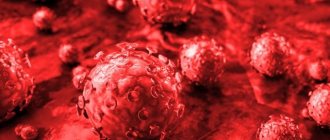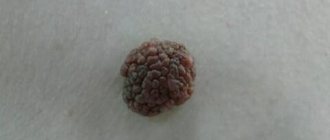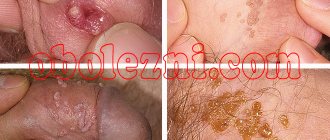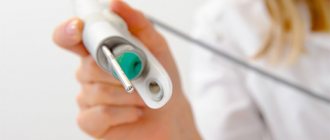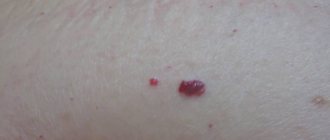Seborrheic warts - causes of formation
The causes of seborrheic warts are unknown. But it is reliably clear that they are not related to the HPV papillomavirus, although their name indicates this. Thus, a seborrheic wart has nothing in common with such epidermal lesions as true condylomas, papillomas and warts.
However, there are some factors that predispose you to developing seborrheic warts:
- Age
. Warts most often appear in people over 35 years of age. Many people have more than a dozen of them; - Genetic predisposition
. The presence of seborrheic warts or other epidermal nevi in immediate family members; - Conditions associated with actinic keratosis
or impaired sebum production.
Symptoms and causes
Warts on the head under the hair are classified into special groups . They can appear either due to infection with the papilloma virus, or under the influence of factors such as age, hormonal changes, or malfunctions of individual body systems.
Symptoms of formations on the head:
- formation that visually resembles cauliflower (the size of the growth may vary);
- round or oval growths on the scalp;
- flat formations of a pink or brownish hue.
A wart on the head in the hair poses a particular danger to humans . Firstly, such growths can go unnoticed for a long time. Secondly, the most common reason for identifying such a formation is its injury.
Reasons for the appearance of formations on the head:
- increased sweating of the head (sweat accelerates the process of virus penetration and its further development);
- abundant accumulations of bacteria (occurs due to poor head hygiene and infrequent hair washing);
- increased secretion of sebaceous glands (may be a feature of the body);
- diseases of the gastrointestinal tract (this group of diseases significantly weakens the body and lowers immunity);
- infectious diseases (can become a complication of this group of diseases);
- constant stressful situations (an unstable emotional state also negatively affects the immunity of the human body);
- abuse of bad habits and lack of a healthy lifestyle (factors lead to a weakening of the body’s protective functions);
- a long course of treatment with potent drugs (a striking example is antibiotics, some of which literally destroy the immune system).
They are among the contagious formations . If growths appear on the head, then the risk of spreading them throughout the body increases.
What does a seborrheic wart look like?
Seborrheic papillomas are characteristic mushroom-shaped skin rashes. However, such a wart can be confused with other skin lesions, such as actinic keratosis or some malignancies, mainly cutaneous melanoma. It also happens the other way around, when skin cancer is mistaken for a harmless seborrheic formation.
Keratinized pigmented lesion
Multiple seborrheic keratomas
Development of seborrheic papilloma
Therefore, diagnosis and treatment of any neoplasms should be carried out strictly by an experienced dermatologist. It is strictly prohibited to independently diagnose yourself, much less remove tumors at home.
Here are the features that distinguish a seborrheic wart from other skin lesions:
- Seborrheic papilloma is well demarcated from healthy skin. It gives the impression of being superimposed on the surface.
- The size of the formation ranges from a few millimeters to several centimeters.
- On the surface of the nipple there are numerous depressions containing an accumulated mass of callus epidermal cells and sebum.
- Depending on the stage of development, the color of the nipple varies from a color similar to healthy skin to dark black, which is not a sign of melanoma.
Seborrheic warts are not accompanied by symptoms such as pain, itching, burning. The exception is mechanical irritation, for example, when changing clothes.
The importance of complex therapy
The effectiveness of HPV treatment in some cases reaches 94%, and relapses are recorded in a quarter of patients. It is important to carry out complex treatment using antiviral and immune-enhancing drugs. The difficulty in getting rid of warts that are on the scalp and hidden by hair is that some forms of medication cannot be used on this part of the body. Creams, gels, ointments get dirty, patches with active substances do not stick to the hairy area. The drugs of choice remain tablets, drops, and injections.
Antiviral tablets:
- Isoprinosine;
- Cycloferon;
- Rimantadine.
Drops of mummifying action are used - Condilin, Dermavit, Solcoderm. It is necessary to introduce interferons designed to increase immunity by activating macrophages and killer cells. Adaptogens are prescribed according to the scheme - lemongrass, echinacea, ginger, eleutherococcus.
Important
Seborrheic warts are benign skin lesions. This means that they cannot turn into cancer cells and be dangerous to health. Seborrheic warts are only an aesthetic problem. Especially when they are on the skin of the face.
The exception is when such a neoplasm is located in a place of constant friction or other traumatic factor. In this case, skin infection may occur. This can result in serious inflammation and even blood poisoning.
What factor provokes the appearance of warts in the cavity?
Due to the widespread distribution of the human papillomavirus, it is quite easy to become one of its carriers. At the same time, a person may not realize that he is infected due to the absence of clinical signs. Symptoms may appear when a woman or man:
- uses personal hygiene items for a sick person;
- often goes to public places (swimming pool, sauna, beach);
- exchanges a welcoming handshake or kiss with a virus carrier;
- often changes sexual partners;
- engages in oral sex (applies to people with non-standard sexual orientation).
All factors do not need to come together for infection to occur. It only takes one of them to become a carrier of HPV. Even a newborn can be susceptible to infection, because when the fetus passes through the birth canal of the mother (and she is a virus carrier), the child automatically acquires the virus.
Seborrheic papilloma and cryotherapy
One of the methods for removing seborrheic warts is cryotherapy, that is, freezing the skin lesions with liquid nitrogen. The wart dies off when exposed to very low temperatures.
Cryotherapy
After treatment with liquid nitrogen, literally a few days after the procedure, the color of the wart changes to black, and the skin lesion takes the form of a scab (crust), which disappears from the surface after a month.
Unfortunately, the procedure carries the risk of leaving an unsightly scar, so cryotherapy is not suitable for removing facial warts.
Features of localization and is the growth dangerous?
Warts form on any part of the head: behind the ear, on the temple, near the eye, on the nose.
Hair growths appear in the following areas;
- parietal;
- occipital
The formation on the scalp is benign in nature. The risk lies in the very localization of such growths; they are subject to mechanical damage from combs, combs, hairpins, hairpins, and razors. Bleeding from the vessels and capillaries feeding them is possible. Increases the likelihood of infection and tissue inflammation.
Seborrheic wart and IPL laser
Another method for removing seborrheic warts is the use of an IPL laser, which completely burns away the skin lesions, leaving a small concave socket.
IPL laser treatment
Within a few days after the procedure, a scab will form, which will fall off after 2-3 weeks. After treatment, a scar may also remain, but, unlike the previous option, it is almost invisible. Therefore, warts on the face are removed with a laser. A similar effect is also achieved by the radio knife, another modern tool designed to remove moles and warts of almost any type.
Types of warts
All growths caused by HPV have a number of characteristic signs. There are several types of papillomas, based on their appearance, shape, and size. Warts have several individual features that distinguish them from others, both externally and in terms of treatment.
Common features
- Simple papilloma is a “classic” wart, keratinized, rough to the touch, rarely exceeding 10 mm in size. It is flesh-colored, which may become brown or gray over time. Often there is one large, maternal, papilloma and several small, daughter ones, which grow around or even on the maternal wart itself.
- Condylomas acuminata are small multiple growths of flesh-colored or brown color. Their sizes vary from 1 to 5 mm in height, formations are localized in areas of increased friction or sweating (neck, armpits, perineum, etc.), but can also affect the eyelids, eyebrows, and scalp.
- Flat - have a lobed structure, flesh-colored or gray in color. They do not rise above the skin level by more than 1–2 mm; as a rule, they are isolated.
Age-related keratomas are not papillomas. The cause of their occurrence is not HPV, but age-related processes in the epidermis, leading to local excessive keratinization. These formations, due to their different nature, will never respond positively to the treatment applied to classic warts.
Seborrheic wart - surgical treatment
Removal of skin lesions with a surgical scalpel involves removal of the wart at the epidermal level. This method is suitable for large lesions on the body.
Surgery
It is important to understand that the choice of method for removing seborrheic papilloma should be made by a dermatologist. Some tumors may raise doubts about their origin, so it is important to preserve the removed tissue for analysis. In this case, the doctor will choose a surgical method, since the laser and liquid nitrogen completely remove the affected tissue, so there will be nothing to take for analysis.
ONLINE REGISTRATION at the DIANA clinic
You can sign up by calling the toll-free phone number 8-800-707-15-60 or filling out the contact form. In this case, we will contact you ourselves.
If you find an error, please select a piece of text and press Ctrl+Enter
Diagnostics
If a wart appears on your head, you should consult a dermatologist. It is difficult to independently determine the type of neoplasm, since they have a similar clinical picture. Before starting treatment, you must be completely sure that the growth is a wart, otherwise it can lead to serious complications.
When making a diagnosis, a dermatologist relies on examination using special instruments, for example, a magnifying glass. In order to exclude the presence of an oncological process, a tissue biopsy is performed. On average, a visit to a doctor will cost 300-1000 rubles, which depends on the city and the doctor’s professionalism.
Preventing the appearance of warts in the mouth
Prevention of HPV infection includes the following measures:
- Have sex only with reliable partners. Protect yourself from contracting dangerous diseases (HIV).
- Do not use other people's toothbrushes. Observe basic hygiene rules.
- If you detect chronic diseases of the body, follow your doctor’s recommendations. It is advisable to be treated in a hospital 1-2 times a year to keep the pathology under control.
- Avoid stress. It is a disruption in the functioning of the nervous system that leads to numerous diseases of the body.
- Boost your immunity. Strengthen your immune system with vitamins and healthy foods.
- At the first symptoms of hormonal disorders, consult a doctor to prescribe appropriate therapy.
- Vaccination is an effective method of preventing HPV. The vaccine saves women and men from infection with papillomavirus types 16 and 18, which are transmitted only through sexual contact.
The article has been reviewed by the site editors
Prevention
In order to avoid accidental infection, you must:
- Strict adherence to personal hygiene;
- Reducing stressful situations;
- Strengthening the immune system;
- Timely treatment of viral diseases;
- Maintaining a healthy lifestyle;
- Proper nutrition;
- Limit close contacts with an infected partner;
- Avoiding hypothermia;
- Complete rest, lasting at least 8 hours.
Traditional methods of removing warts
Alternative medicine offers hundreds of methods, but not all help equally. If you want to remove a wart, you should try several recipes. If grandma's recipes didn't help, you'll have to visit a dermatologist.
If the upper part of the formation turns black, the method is considered correct; this indicates drying of the roots. You cannot cut off the wart; it is better to wait until it falls off.
According to the lunar calendar, wart removal begins with the full moon, continuing until the birth of the new moon. There is a break until the full moon.
Plants, herbs, berries, vegetables
A simple remedy will help remove a wart - fresh, yellow celandine juice. For 1.5-2 weeks, process up to twice a day.
For 10 minutes, once every 2 days, steam your hands in a heated thyme decoction. Repeat 5 times. Decoction: cook for 15 minutes. a glass of herbs in 1 liter of water, then leave for 2 hours.
